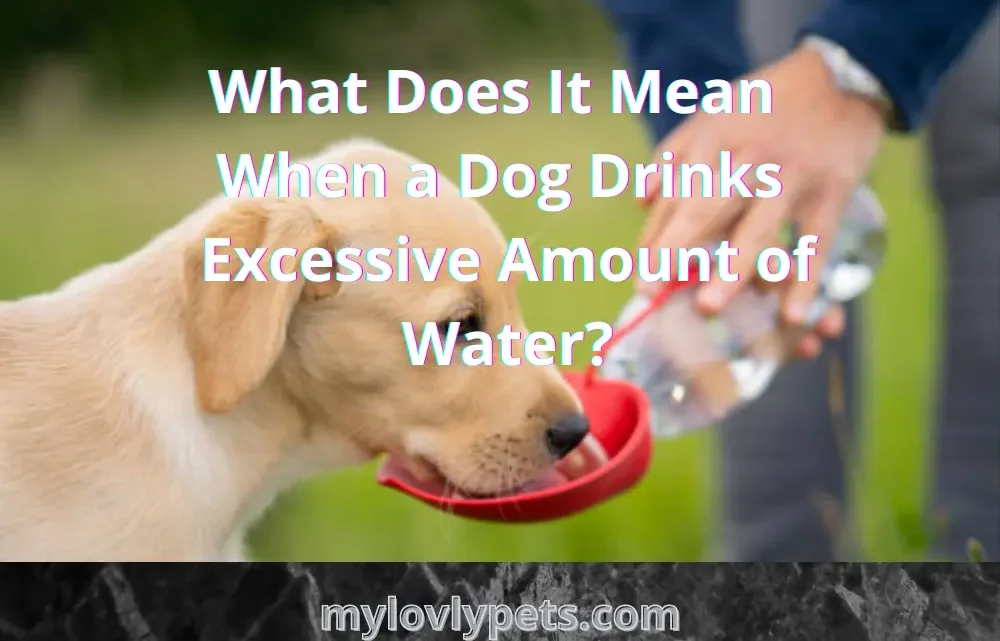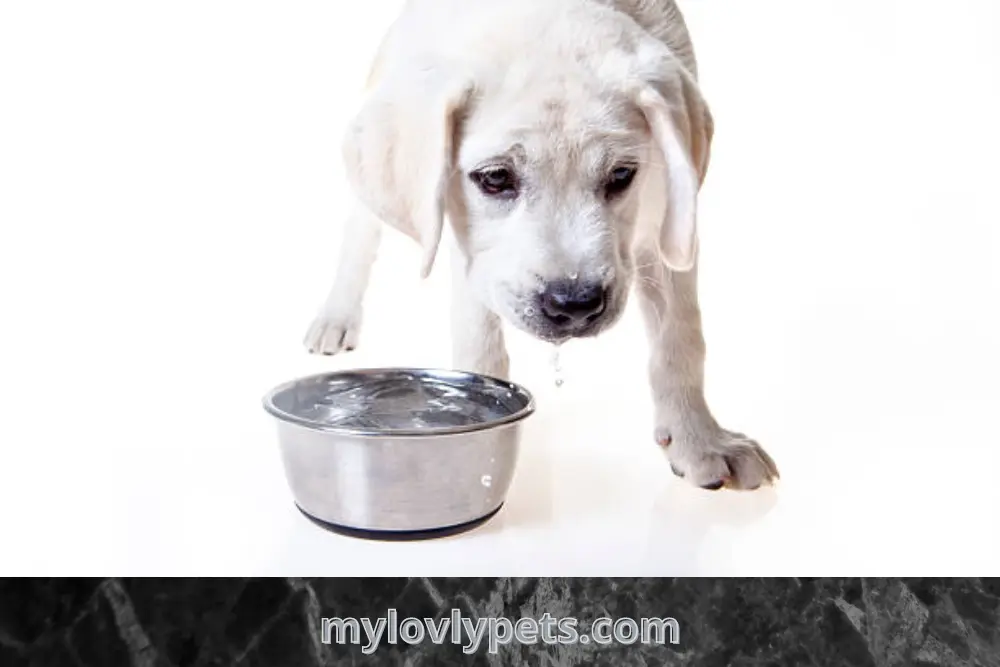
What Does It Mean When a Dog Drinks Excessive Amount of Water?
Dogs have basic requirements such as eating, walking, being petted, and drinking water. So, you’re wondering, ” what does it mean when a dog drinks excessive amount of water?” when all of their needs have been addressed and they’re still consuming significantly more than usual.
Let’s start with how much water your dog needs each day.
How Much Water is My Dog Drinking?
Every day, a dog should drink half an ounce to an ounce of water for every pound it weighs. So, a dog of 25 pounds needs between 1.5 and 2.5 cups of water daily. It must take into account the dog’s size, age, degree of activity, environmental conditions, and climate to arrive at an accurate estimate of how much water it needs each day.
This means you should keep track of how much water your dog drinks to establish a baseline. Checking the water level in one dog’s dish is simple, but in a household with multiple canines, it can be more challenging. Then you should log how often each dog goes outside to urinate.
What Happens if a Dog Drinks Too Much Water?
Because they lack sweat glands, dogs cannot shed excess water the same way that people can. Because urine is the fastest way for a dog to get rid of excess water, that’s what happens when they drink too much water.
Sometimes, dogs can become intoxicated on water. Here, canine overhydration alters the balance of important cellular ions like sodium. This disease can be fatal for many dogs. It’s important to note that dogs almost never get this by drinking water alone. When dogs drink too much water at once when swimming or from a pressurized hose, they might become water intoxicated.
In some dog species, bloat from drinking too much water can be fatal. Dogs with large, barrel chests and narrow waists are more likely to develop this condition.
A dog’s access to water, however, should never be limited by its owner. Dogs who are more prone to bloats, such as German Shepherds and Great Danes, should avoid consuming for at least 30 minutes after activity.
The bottom line is that you should take your dog to the vet if you see any abrupt and extreme changes in his behavior, especially with regard to his water consumption.
Possible Reasons Why Your Dog is Drinking a Lot of Water

If you find that your dog is consuming far more water than you would expect, what does this indicate?
What does it mean when a dog drinks excessive amount of water? There are a variety of reasons why a dog might consume a lot of water.
Dogs’ Thirst Has Increased
Polydipsia is excessive thirst, and polyuria is frequent urination.
If your dog drinks a lot of water during the night, it may be for one of a few easy-to-understand reasons. Perhaps he sleeps for long stretches during the day and then tries to make up for lost time at night. It’s possible that in the summer a dehumidifier is removing moisture from the air at night, and that in the winter the heat from the furnace is doing the same thing.
If you suspect that your dog’s thirst is the result of something other than exercise or a change in the weather, you should take him to the vet for diagnostic testing. Some of the causes of a dog’s excessive thirst are listed below.
Dehydration
Heatstroke, vomiting, diarrhea, insufficient water intake, illness (liver/kidney disease/diabetes), medications, and exercise can all contribute to your dog becoming dehydrated. Here are some signs of dehydration:
- Skin sagging
- Loss of hunger
- Diarrhea or vomiting
- Lack of motivation and sluggishness
- Panting
- The eyes are dry and sunken.
- Chapped, cracked lips.
Infection of the Urinary Tract (UTI)
Urinary tract infections (UTIs) in dogs can be caused by a number of different things, but the two most prevalent are bacterial infection and bladder inflammation. Urinary tract cancers, diabetes, bladder stones, and renal illness are further factors. Keeping your dog hydrated will increase the frequency with which he urinates, which in turn will help rid his body of bacteria and improve his immune response to the infection.
Some of the symptoms of a urinary tract infection in your dog are:
- Urine that is pink or hazy
- Crying or straining when urinating
- House accidents Frequent trips outside
- Urinary duct licking
- Fever
Infection of the Kidneys
A kidney infection, like a urinary tract infection (UTI), is an infection of the kidney(s). Usually, there’s a pre-existing condition. such as chronic kidney disease, kidney stones, partial obstruction of the urinary tract, or a bladder infection. The immune system is already under duress from fighting off an infection, and this only makes things worse.
Some symptoms of a kidney infection include.
- Urine that is pink or hazy
- Urinary distress Increasing frequency and volume.
- Decreased hunger.
- A powerful odor of urination
- Fever
- Fatigue
- Vomiting
Renal Failure
The strain of dehydration on your dog’s kidneys can reduce blood flow, which can eventually cause kidney failure. Heat stroke, poisons, bee stings, snake bites, or anything else that causes significant, rapid tissue damage can lead to acute renal failure.
The slow loss of function over weeks, months, or years that characterizes chronic kidney failure, which is frequently associated with age, makes it even more dangerous. Unfortunately, by the time your dog starts showing signs of kidney failure, the damage has often progressed significantly.
- Dehydration
- excessive thirst and drinking
- Excessive urination and/or urinary retention Blood in urine
- Pale gums, fatigue, and anemia
- Painful sores in the mouth
- The loss of appetite is clearly noticeable.
- Chemically scented bad breath
- Loss of body fat or weight
- Frequent vomiting
- Urine production slows down or stops altogether in the latter stages
Diabetes
An increase in thirst and urination frequency may be symptoms of diabetes mellitus in your dog.
Dogs of any age can get diabetes, though it is more common in canines of middle age and older. Obesity, chronic pancreatitis, steroid use, and a poor, processed food diet that’s high in carbs and inflammatory omega-6 fats all put dogs at risk.
The answer to the question, “Why is my dog drinking so much water and not eating?” may lie in a diagnosis of diabetes.
The symptoms of diabetes in dogs are listed below.
- Acute dehydration and thirst
- Intense hunger and/or weight loss
- Pancreatitis-related vomiting Weakness or tiredness
Why is My Female Dog Drinking So Much Water
Pregnancy could be the reason your female dog is guzzling so much water. During the final stages of pregnancy, a female dog’s thirst will increase. If nothing else, female dogs drink a lot for the same reasons that male dogs do.
Female dogs that haven’t been spayed are in danger of pyometra. In this condition, bacteria invade the uterus and create an infection. A vaginal discharge is possible if the cervix is open, and the infection is able to drain.
When the cervix closes, the dog’s rapid decline is due to the accumulation of pus inside the uterus. Unfortunately, both types of pyometra can be fatal if not treated right away. Some other symptoms of pyometra in dogs include vomiting, loss of appetite, and lethargy.
Other Reasons to Drink Lots of Water
Dogs’ water intake might increase for a variety of reasons, including bad habits, getting older, and other common factors.
High Levels of Activity
After vigorous exercise or play, it’s typical for a dog to consume a lot of water and pant heavily. After heavy drinking, your dog pants to replace his oxygen levels. Give your dog frequent water breaks to prevent him from choking on his thirst.
Your dog may be drinking too quickly if you see him gulping down large amounts of water all of a sudden and then throwing up or regurgitating it. Give him a little to satisfy his thirst and slow him down. If this is a recurring issue, your dog may have esophageal or digestive issues.
Canines That Are Getting Old
It’s natural to question, “Why is my senior dog consuming so much water?” if you have one. The kidneys of an older dog don’t work as well as those of a younger dog, which is a contributing factor. Maybe you brought home a new, hyperactive puppy, or the weather was warmer or colder than usual, and now he’s thirsty.
When a change in your pet’s behavior cannot be attributed to a change in their diet or other lifestyle factors, you should have your veterinarian perform diagnostic tests to rule out any underlying diseases.
Winter Drought
Since humidity drops with the winter weather, you may notice that your dog drinks more water than usual throughout the winter months. Every time he breathes, he loses moisture; he must drink more to compensate.
If your dog suddenly begins drinking more water than normal, it’s important to figure out why. Provide him with clean, filtered, or spring water all of the time.
When to See the Veterinarian If Your Dog Is Drinking a Lot of Water
It’s a good idea to keep track of how much water your dog consumes if you have concerns that he or she may be drinking too much. To accomplish this, fill their dish with a specific amount of water (one liter, for example) and then measure out how much remains after a day has passed. Make sure to keep track of how much more you add if you have to top out the bowl.
If your dog consumes more than 100 ml per kilogram in a 24-hour period, you should take them to the clinic. However, smaller doses might also be weird, so trust your senses. Keeping a diary or making a mental note of any additional symptoms is helpful. Don’t wait to see a vet if your dog has suddenly been drinking a lot more water than usual, acting sick, or throwing up.



[…] cause of cystitis in dogs. Urinary stones and crystals, bladder inflammation, incontinence from drinking too much water or a weak bladder, kidney disease, cancer, stress, spinal cord disease, prostate disease, and […]